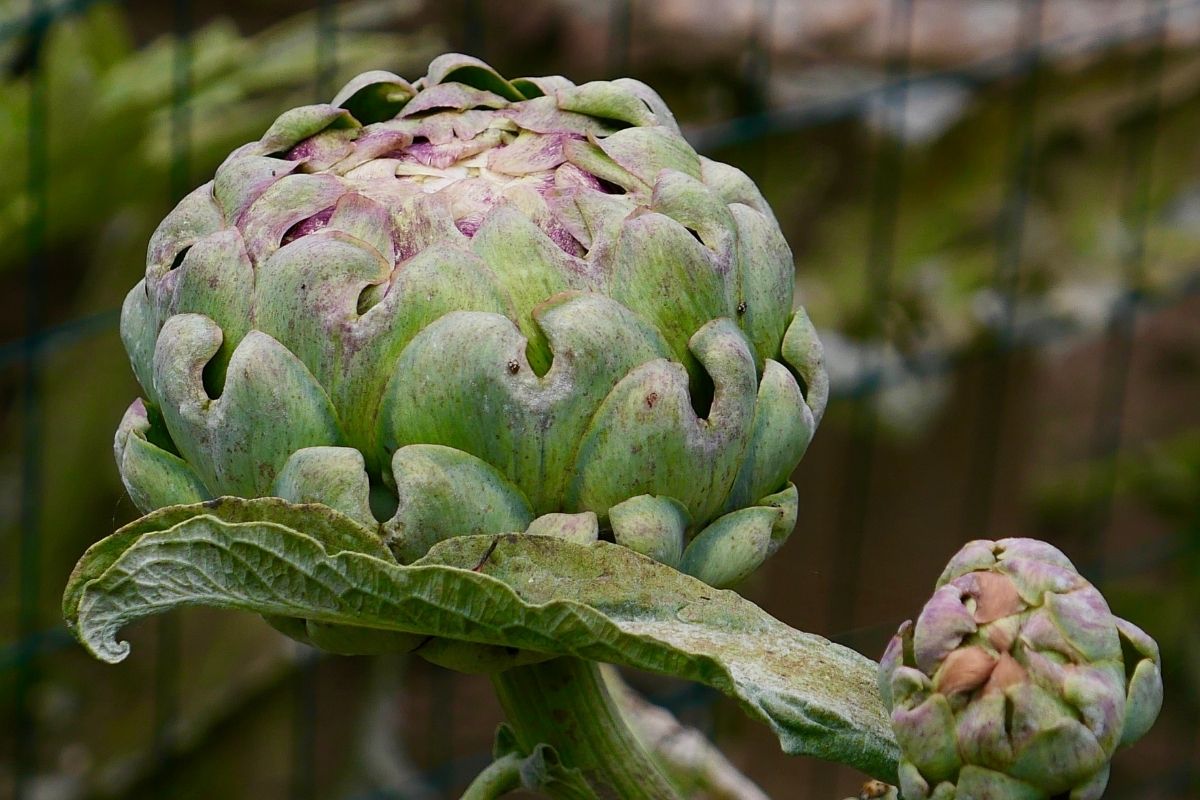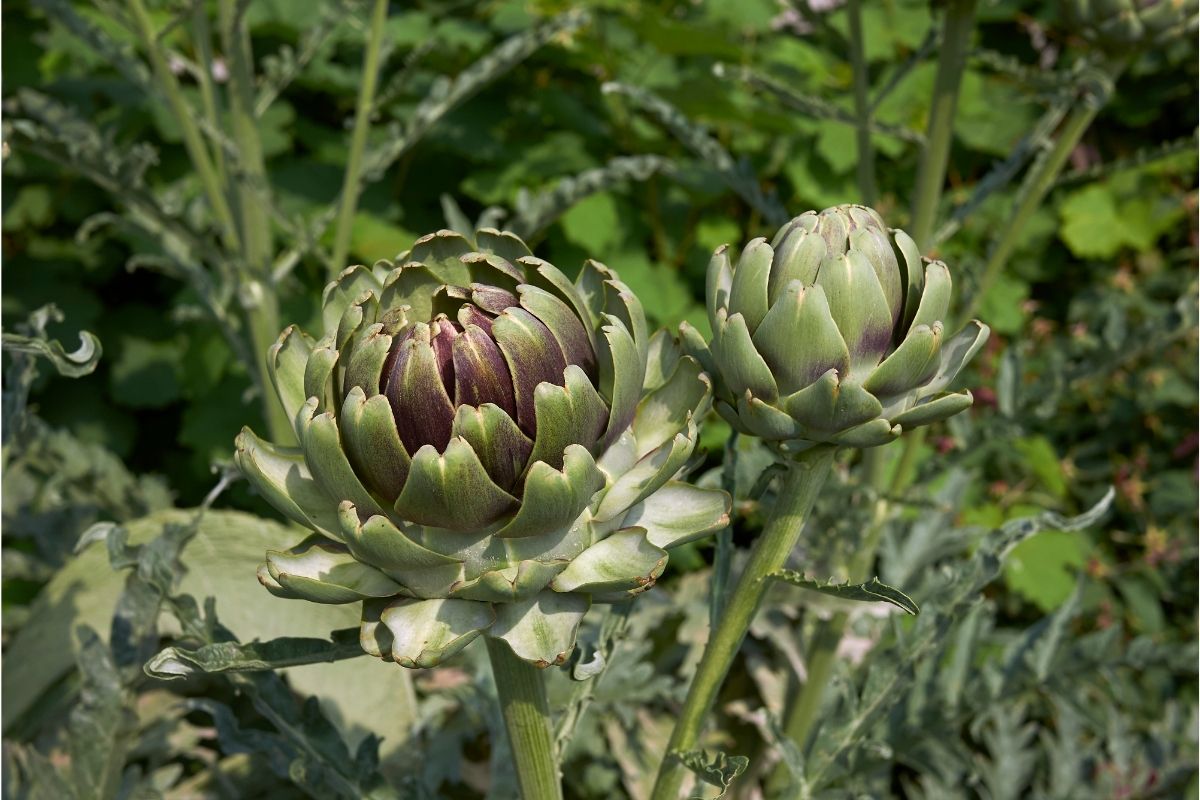The artichoke is a type of thistle that produces edible fruit. The edible portion of the artichoke plants are known as the heart, at the base of each bract there is also an edible part.

The actual botanical name for the artichoke would be Cyrana cardunculus var. scolymus.
While the plant is grown for its heirloom usage in food produce it also produces a beautifully purple flower that can have its own ornamental uses.
This is due to the artichoke actually being a variety of another Mediterranean vegetable called Cardoon which is known botanically as Cynara cardunculus.
Artichoke is actually a sub variety of Cardoon, yet the artichoke has certainly eclipsed the Cardoon in terms of culinary usage and heirloom cultivation.
As they are a large staple of Italian cooking they have become somewhat popular in America through the Italian immigration post war. They brought over recipes and dishes as well as new ingredients such as Cardoon and the artichoke.
Artichokes are generally endemic to the Mediterranean peninsula and have been eaten by the ancient Roman and Greek populations throughout history.
Heirloom cultivation actually goes back quite far, In the beginning of the classical period different artichoke varieties were being cultivated for culinary purposes in Sicily, although they referred to it as kaktos then.
The artichoke was then later introduced to the Dutch who took it with them on their pilgrimage and introduced to England and later to the US by French and Spanish immigrants.
In modern horticulture, the artichoke has become quite popular especially in Europe as well as the US. California actually produces 100% of the artichoke crop in the US, and 80% of that crop comes from Monterey County which, perhaps ironically, calls itself the ‘artichoke Centre of the World.
Consider visiting their Castroville artichoke Festival if you love these spiky friends as much as they do!
1. Cynara Cardunculus Var. Scolymus ‘Colorado Star’

This artichoke is an heirloom variety of artichoke specifically bred to be grown in the US. As Colorado, the namesake of the food and home to the rock mountains, generally have smaller growing seasons due to the weather.
This particular cultivar is made to come to maturity much earlier than the normal artichoke which can be considered to be slow growing. This cultivar can reach maturity in a mere 75 days making it particularly sought after.
Although, as a result of the shorter growth time, these types of artichoke are often much shorter, growing to around 3 feet in height potentially. While this is a by-product of the shorter growing period, this can actually make them pretty well suited to grow in smaller more compact areas.
Grow them all in one patch along with permaculture practices and they will still grow large within a small area.
2. Cynara Darunculus Var. Scolymus ‘Emerald’

This is another obvious demonstration of heirloom cultivation. This cultivar is specifically grown, and was bred, for its ability to be ‘productive’. This means that the cultivar will produce more and be more productive than regular varieties.
It’s said that this ‘Emerald’ cultivar can produce anywhere from 10 – 12 flowers each season, even in its first year.
This gets rid of a lot of faffing around for Farmers who have other crops to tend to. They are both cold tolerant but also require little to no vernalization making them well suited to warming climates too.
Moreover, this artichoke variety is thornless which makes it a little better to sell commercially as it isn’t as likely to prick people.
3. Cynara Cardunculus Var. Scolymus ‘Green Globe Improved’

This shows how heirloom varieties can sometimes improve on what was already popular. ‘Green Globe’ was one of the original heirloom varieties of artichoke and was pretty popular among heirloom cultivators.
This ‘Green Globe Improved’ variety makes what was already a productive species even better for heirloom cultivation.
The ‘Green Globe Improved’ cultivar has much fewer spines than the ‘Green Globe’ variety and can be eventually more productive. This cultivar can produce three to five flowers in its first season and this can increase as the seasons progress.
One thing worth mentioning is that this cultivar does reach maturity in more time than the original ‘Green Globe’ but will produce more food when it does reach maturity.
4. Cynara Cardunculus Var. Scolymus ‘Imperial Star’

Imperial Star remains an heirloom cultivar that is similar to the Colorado Star, but is ideal to grow for home gardeners. The artichoke is a little smaller than even the Colorado Star cultivar, yet it has a few upsides that make it a worthy heirloom variety.
The ‘Imperial Star’ is perhaps one of the smaller cultivars but this makes it perfect to grow at home. The plant grows to be around half a foot to four feet tall which means that they are ideal to grow in planters or in a polytunnel.
Yet in more wider farming contexts this can mean lots can be harvested at one time and less ground area is taken up by each plant.
This cultivar will provide a much earlier harvest even in the first year of growth. The small artichokes should be ready to harvest as early as 85 to 90 days. Moreover, the cultivar has good resistance to frost and disease.
5. Cynara Cardunculus Var. Scolymus ‘ Purple Romagna’ Syn. ‘Violetto Di Romagna’

This is a heirloom cultivar that is grown for specimen size rather than large crop hauls. This cultivar that comes from Italy produces large flowers that hold within them a large and tender heart – just like us.
Moreover, the plant is beautiful as it is colored a swollen purple color that is pretty ornamental. The whole plant can reach heights of 5 to 6 feet.
They remain perennial above a Hardiness Zone of 7, anything below this they can be annual varieties. Yet, a truly prolific harvest of these artichokes should occur around 85 to 100 days into growth.
6. Cynara Cardunuclus Var. Scolymus ‘Violet De Provence’

This is another variety that is productive and produces a crop nice and early in the season. While the cultivar is rare to find outside of Europe it is certainly made to produce good crops even in warmer climates which makes this plant particularly good to look at if growing in southern US states.
What’s worth noting about this heirloom variety is that the buds are particularly small, creating what some report as ‘mini artichokes. Yet, the crop should produce quite a lot of them.
As they are small they are very tender and can even be eaten raw, which makes them preferable to some growers. Moreover, as the buds are small and brightly swelled with purple color, they can be fairly ornamental.
After 120 days they should produce flowers that can be harvested, what’s good about this cultivar is that once perennialized they can produce food for several years if kept well.
RELATED: A Is For Artichoke: Amazing Veggies That Start With ‘A’
7. Cynara Cardunculus Var. Scolymus ‘Purple Italian Globe’

This cultivar is a large purple Italian variety that remains pretty tolerant to both heat and cold. The cultivar produces around six to eight heads of artichoke. The heart of these artichokes are particularly sought after in the culinary community for being particularly tasty and tender.
Around 120 days of growth is required before the plant can be harvested but the outcome after 120 days will be the large and deep purple heads that are truly ornamental and beautiful, so take a moment to admire their beauty before harvest.
Final Thoughts
Growing artichokes is a practice that has been kept up since the times of Ancient Greek and Roman civilization. We have always considered the artichoke as one of the true Mediterranean vegetables.
Many Americans may have not even heard or tasted an artichoke before but we can’t recommend it enough, not only growing them but actively using them in cooking.
Any of these cultivars are great choices for your garden.
While cultivars like the ‘Colorado Star’ are great to consider as they can grow really well in the hot climates of the southern US states, other varieties such as ‘Imperial Star’ and ‘Violet de Provence’ are also great cultivars to consider as they are smaller you can grow them easily at home in your garden.
Why not grow some of these cultivars this season and see if the artichoke is for you, you could really impress your friends by bringing this veg out at a dinner party, or you could easily impress your neighboring gardeners by growing this in America!
They could spruce up your pasta game as well as your garden!
Artichokes can be grown in any situation and are a great addition to any garden and pantry. There is so much to use artichoke for in terms of culinary uses such as pickling, cooking until tender, eating raw, using in a dip, and endless application with pasta and other Italian dishes.
So get experimenting and see how your gardening adventures can make you a potentially better and more cultured cook. Both can really impress family and friends with your knowledge.
We hope you learned something from this article, here are other articles that you can learn from:
Peppers: Are They Fruits or Vegetables? All The Top Information You Need To Know







